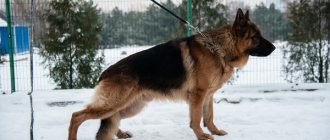When we decide to live with a dog, we must consider its reproductive cycle. Whether you are considering breeding a dog, knowing what to expect is essential for its health and well-being. For female dogs, it is especially important to know about their heat cycle, which is the different stages of fertility. The heat cycle is the only time during which fertilization and pregnancy can occur. If your dog has already become pregnant, you can make sure it doesn't happen again.
For this reason, many people ask, when does a dog go into heat after giving birth to puppies? Here we answer the question by looking at a dog's heat cycle and what we should consider if our dog is pregnant.
How to detect heat in dogs
To know that a dog is in heat, you need to have a rough idea of the signs that a dog is in heat. And for this you need to know the estrus cycle.
A dog's estrus cycle includes 4 stages. Each cycle has its own signs of a dog's heat, and a dog's behavior during heat changes depending on the cycle.
- Proestrus is the period of pre-estrus. Signs of a dog's heat at this stage are quite easy to recognize. The bitch's external genitalia (loop) swell, dark bloody discharge appears from the vagina, and the dog begins to actively lick itself. The bitch’s behavior also changes: she actively flirts with males, but does not allow them to approach her. Dogs begin to mark their territory and become more aggressive towards other females. At the pre-breeding stage, the bitch is not ready for mating. A dog's estrus lasts 7–10 days.
- Estrus (sexual heat) is the second stage of estrus in a dog. During this period, the bitch is ready for mating. On average, the estrus period lasts 4–12 days. During this period, the bitch allows the male to come to her. Signs of this stage of estrus in a dog: at the sight of a male dog, the bitch freezes, arches her back and moves her tail to the side. During this period, the discharge becomes lighter (pale pink)
- Metestrus is the third phase of a dog's estrus cycle. During this period, the active phase of the dog’s estrus ends and the recovery period begins. You can determine this period of estrus in a dog by the following signs: bleeding disappears, swelling of the genital organs subsides. During this period, a false pregnancy may occur. On average, this period lasts 60 – 105 days
- Anetrus is the fourth phase of the cycle. The period of sexual rest, which lasts 100 - 150 days.
Can a dog have puppies after giving birth?
Categorically speaking, as long as the dog remains healthy, she can become pregnant again as soon as her next heat cycle begins. Their fertility may last for the rest of their lives. As a dog gets older, the heat cycle may occur less frequently and with less intensity, but it does not necessarily stop.
It is possible for a dog to become pregnant again after giving birth. When this happens depends on when the previous heat period passed. This development does not stop with breastfeeding now that the dog is caring for her new litter.
© shutterstock
Discharge in dogs during estrus
It is possible for a dog to be in estrus without excreting – the so-called hidden estrus. Estrus in a dog without discharge may be normal and not a sign of any abnormalities or disturbances in the cycle. During estrus in a dog without discharge, the necessary process in the ovaries still occurs (formation of follicles and release of eggs from them). If a bitch is bred in time, she will bear and give birth to healthy and full-fledged offspring. The causes of estrus in dogs without discharge are still not clear. Cases of hidden estrus are extremely rare.
However, estrus in dogs without discharge may have another cause - hypothyroidism. This may be the reason for the sluggish manifestation or absence of estrus symptoms at all. Hypothyroidism is associated with decreased thyroid function. Females suffer from this disease 2.5 times more often than males.
Typically, the color of the discharge during a dog's heat changes depending on the cycle. At the beginning of the dog's heat, the discharge is dark red in color, but in the second half of the dog's heat, the discharge lightens to a pale pink color.
Signs and symptoms
The most important symptom of the onset of a period is a change in behavior and mood under the influence of hormones. The dog becomes active, playful, mischievous, and intractable. This manifests itself differently in each individual. Some pets require more attention, while others tend to hide away from people.
Other symptoms characteristic of a female during sexual estrus:
- The animal goes to the toilet more often, marks its territory to attract males;
- The loop swells, loosens, falls;
- Bloody discharge appears, which eventually changes to light or transparent;
- A girl licks her genitals;
- May react actively or aggressively to male dogs;
- The appearance of a specific odor (this may appear at a certain period of the cycle or accompany the entire estrus, the intensity depends on individual characteristics);
- Possible shedding before the start of the period.
A dog is in heat: what to do
If you do not plan to breed your dog, you should be careful during heat. What should an owner do when a dog is in heat?
First of all, lead your bitch on a leash. Even the calmest dog's behavior changes during heat, and it can unexpectedly take off running.
Do not allow male dogs near the bitch. If the male makes a cage, it is no longer possible to separate the dogs.
Do not attend exhibitions and other events. This is fraught with trouble not only for you and your dog, but also for those around you.
Do not allow your dog to swim in bodies of water - a genital tract infection may occur.
Childbirth does not delay estrus
Childbirth does not delay estrus. In small dogs, the likely time of onset of estrus is within 4 months from the birth of the puppies. Deviations happen. If estrus begins prematurely by 2-3 weeks, this is not a pathology. The cycle is calculated from the start date of estrus, even if the owners bred the dog during it. The pregnancy period is taken into account when calculating the cycle.
As an option, it is possible to do an ultrasound of the lower pelvis after the end of your pet’s “critical days.” If the tests show normal indicators, it means that the girl is simply fertile and is ready to give birth to puppies much more often than other females.
Estrus without mating
Often, pregnancy is not planned by the owners, either the female is too young or has recently given birth to puppies. In this case, estrus occurs without mating, which does not affect the health of the pet if all hygiene rules are followed.
- Firstly, you need to monitor the dog and its communication with males.
- Secondly, use odor blocking drugs. They are applied to the back of the body. This allows you to walk your animal without fear of attracting a crowd of unwanted “gentlers”.
Duration of estrus
The duration of the process has a direct connection with the breed characteristics and dimensions of the ward. Small dog varieties first come into heat at about six months of age (this is an approximate estimate). At the same time, some breeds, for example, the Yorkshire Terrier, will experience their first heat only around the age of one year.
In general, you need to be especially careful with small breeds of dogs during heat. In principle, it makes no difference to males what size your pet is. The powerful sexual instinct erases all dimensional boundaries. But for your baby this can become a big threat, because there is a likely risk of injury. Even if, by a happy coincidence, spontaneous mating takes place without consequences for the bitch, then the offspring from a large male simply cannot fit in the small uterus of the animal, and this can be fatal.
Estrus in dogs, regardless of breed, lasts at least 20-22 days, twice a year in young dogs and once in old dogs.
In large canine varieties, puberty occurs a little later, at approximately 12-18 months. The duration of estrus is individual for each individual, but it is believed that the optimal time for a successful mating is 12-14 days from its beginning, after which the bitch becomes more and more inert to the encroachments of males and by the 23rd day finally stops responding to them.
What signs can you use to determine if a dog is in heat?
Drops of blood on the sofa and floor, frequent urination, strange behavior uncharacteristic of a dog - all these symptoms indicate that the female has gone into heat.
Signs of heat:
- My pet asks to go outside to the toilet more often than usual. In this case, the female can mark every bush and every tree with her urine. In rare cases, the dog begins to pee in the house, trying to mark all corners and pieces of furniture with its scent.
- Bloody discharge with a specific odor oozes from the female’s genitals. In all places where the pet sat or lay, bloody drops remain, indicating that she has begun to go into heat.
- Sometimes animals begin to shed intensively during this period, leaving tufts of fur all over the house.
- When a dog is taken for a walk, it shows an active interest in all the male dogs running past. In this case, the pet may try to break off the leash and run away from the owner.
- During the period of estrus, the character of the animal also changes. Sometimes the pet becomes overly excited and playful or behaves disobediently, not responding to the owner’s comments and commands. Some females, on the contrary, become lethargic and sad, do not want to play and even lose their appetite.
- A sign of estrus can also be the fact that the dog often licks its genitals, in particular after each trip to the toilet.
- Representatives of large breeds can behave viciously and aggressively even towards the owner. Therefore, it is advisable to limit walking with the dog, especially in places where children walk.
If the period of estrus coincides with the training and education of the dog, then classes must be postponed, since at this time the animal is not able to perceive and remember commands.
Possible problems and consequences
Possible problems include variations in timing. Contact your veterinarian if:
- the appearance of a delay of 9-10 months;
- menstruation lasting less than 10 or more than 30 days;
- any deviations in the cycle after 2 years, including a delay in the first emptying;
- increased frequency of menstruation;
- abundance or intense color of discharge.
The animal may also experience a false or unwanted pregnancy. The first can be eliminated with medication, and the second can be eliminated by competent avoidance of male dogs or surgical intervention.
How to discourage male dogs
In addition to walking on a short leash, it is possible to use sprays that fight off the smell of a bitch in heat. They are applied to the back of the body before each walk. Domestic products are also represented by BioVax.
Unwanted pregnancy
Unwanted pregnancies are treated with abortifacients or surgery. In the latter case, the surgeon cuts out the uterus, which excludes the dog from further breeding.
False pregnancy
If you notice signs of pregnancy in an unmated pet, contact your veterinarian. Physiological changes occur due to an excess of progesterone and rarely disappear on their own. In most cases, the problem can only be solved with drug treatment. Without the help of a veterinarian, there is a high chance of developing mastitis or pyometra.
“ More about false pregnancy in dogs
If there is no heat
It is worth understanding that the organisms of each individual are individual and cycles can develop differently. According to generally accepted veterinary standards, estrus should occur twice a year, but ideal coincidence of intervals is a rare case. The regularity of the process is monitored only in experienced strong females aged from 4 to 7-8 years .
Young females are extremely unstable. The first heat does not have to go according to schedule. It is considered normal if a dog begins to leak at 6-18 months. The next phase is planned after 4-8 months , sometimes after 1 year . It depends on the breed (Laikas and Greyhounds breed less frequently), size, and psychological state. It is worth contacting a veterinarian if the heat does not occur for more than a year, and the second and third do not come within 6-8 months .
If the owner plans to breed or breed puppies, then it is important to monitor the frequency of the cycles, but there is no need to worry about delays, especially if the female feels normal.
If there are cycle disorders in an adult, there is no need to panic right away.
- Firstly, the owner could simply have determined the date incorrectly.
- Secondly, there are different durations of the quiet phase. Usually, long and short alternate. Therefore, the delay may be just a long phase; it usually occurs in the autumn-winter period.
Another reason for delay or failure is the simple aging process of the body. Older females flow less frequently, this should not bother the owner, although it is still necessary to monitor the phases. Dogs do not have a complete stop in reproductive activity; the absence of estrus in this case requires a trip to the veterinary clinic.
Sometimes estrus is delayed due to negative environmental factors. The pet's body can independently decide when it needs to block reproduction. For example, if the conditions for the birth of puppies are currently unsuitable, the female is subject to severe stress, works or trains hard, and eats poorly. Relocations, changes of owners, and climatic conditions may affect this.
If there really is a delay, then there is reason to worry. In this case, you should contact your veterinarian to determine the cause. The absence of estrus is not always a dangerous disease. There are several congenital problems not related to diseases of the reproductive system, which are characterized by instability of the cycle, but do not harm the health of the animal:
- Anostria is a congenital pathology in which sexual estrus never occurs and estrus does not occur; may manifest itself in the form of a galloping form, when regular estrus is replaced by their long-term absence;
- Subacute - almost imperceptible phases of estrus, which can only be detected through analysis.
The absence of sexual heat can also be a symptom of serious diseases that cannot be determined only through observations and conclusions. The cause may be inflammation of the uterus, tumors, hormonal imbalances, dysfunction of the thyroid gland and pituitary gland. In this case, the specialist will prescribe tests: ultrasound of the pelvic organs, urine and blood tests, cytological analysis and other research methods.
Preparation for mating and its implementation
Mating is carried out on the 11-15th day of the third emptying in the territory of the dog. 1.5 months before mating, animals are dewormed and checked by a veterinarian.
According to the method of knitting, it can be free and manual. In the first case, the animals do everything on their own, and in the second, their owners help them. Hand knitting is typical for small breeds and untied animals. During this process, the owners help to mount and wait for mating - 5 minutes of mating after ejaculation. To consolidate the result, it is recommended to knit again.
How many days are there?
The duration of the cycle depends on several factors: nutrition, conditions of detention, age, size, breed. A specific value can only be determined through observation and recording of data. On average, the period lasts 20-25 days . Although the first heat is often short-lived, it can last 3-5 days . Stability of the cycle appears only by 2-3 years.
How long does it last for representatives of small breeds?
Puberty occurs earlier in small dogs; as a rule, the first heat appears at 6-12 months . It lasts no longer than 10 days . The next phase comes after 6-8 months and lasts about 18-20 days .
In large breeds
Large dogs mature later, at 12-18 months . Due to their size, the volume of secretions is greater than that of small females. The duration of the first cycle lasts up to 15 days , and subsequent phases take place in 25-30 days.
Husky and miniature schnauzer: advice from veterinarians
When a Husky goes into heat after giving birth, the dog will show the same signs as other breeds. Repeated estrus in a husky after she has whelped occurs after 4-7 months. It proceeds in the same way as in other dogs.
However, breeding Husky dogs is quite a troublesome task. The female is responsible for the quality of the offspring of this breed. The relationship between a bitch and a dog is built over a long period of time.
However, there is still a difference. If dogs of other breeds can be bred after 1 heat after giving birth, then in the case of a husky it is better to wait out 2 or even 3 heats. This is necessary for the dog to fully recover and become stronger for breeding the next offspring.
When a dog goes into heat after giving birth, it is difficult to call the miniature schnauzer to order. This breed is distinguished by its aggressiveness during estrus and mating, despite its small size.
Estrus is no different from other breeds. It is recommended to breed a bitch after giving birth for the third mating, no more than once a year. After 9 years, mating is stopped completely.
Estrus and health
Owners of unsterilized female dogs need to be aware of several health-related issues. This will help you make decisions about surgery if necessary.
Recovery of the cycle after childbirth
The cycle normalizes 4-6 months after birth. The delay time depends on the duration of lactation and the size of the litter. To fully restore the body, it is recommended to wait until mating until the next menstruation.
False heat
This kind of estrus occurs in young bitches. It is accompanied by all the listed signs, but excludes ovulation. Because of this, any attempt at mating is doomed to failure. This phenomenon is not dangerous to health and is characterized by a sudden disappearance of the symptoms that have arisen.
Hidden heat
This menstruation is the opposite of false menstruation, that is, it is accompanied by ovulation without obvious symptoms. In rare cases, the situation is explained by a pathology of the thyroid gland, so play it safe and undergo a full examination at the veterinary clinic.
Dog sterilization
Due to the high likelihood of developing cancer in unsterilized and uncrossed dogs, veterinarians recommend sterilizing all animals not involved in breeding. The operation is carried out 14-20 days after the end of emptying.
Is it possible to vaccinate a bitch in heat?
Veterinarians have not reached a consensus on this issue. In the presence of chronic diseases and severe pain, it is recommended to wait until the end of menstruation. Vaccination of healthy individuals is acceptable.
Regular monitoring of your menstrual cycle will help you avoid possible problems. With it you can easily identify abnormalities that require a visit to the veterinarian. Avoid using hormonal medications and consider sterilization. Remember that the earlier the operation is performed, the lower the likelihood of developing cancer and other dangerous diseases.
The article is for informational purposes only. Contact your veterinarian!
Do you like the article? 0











